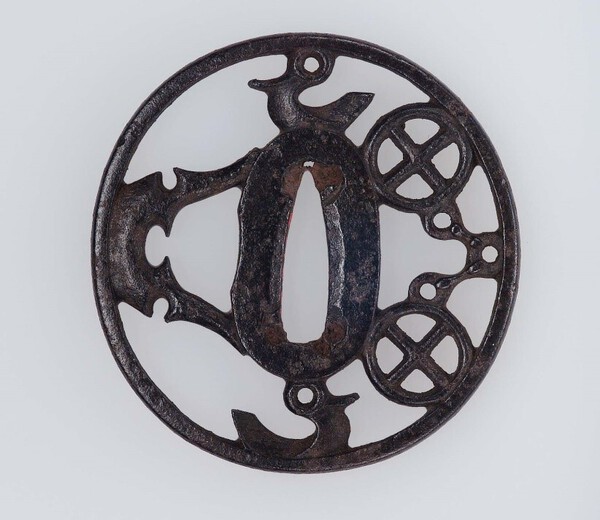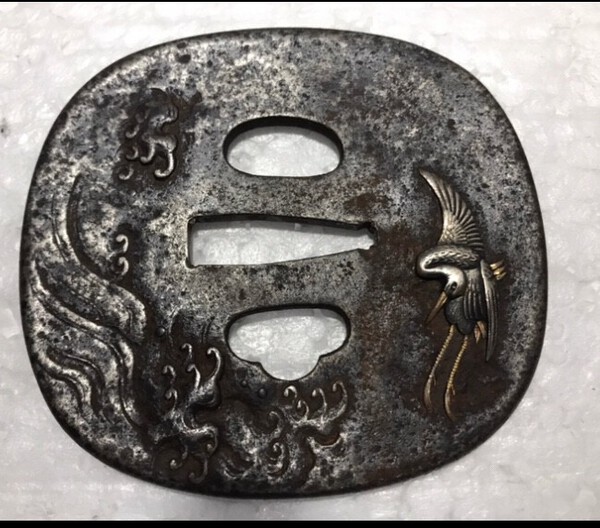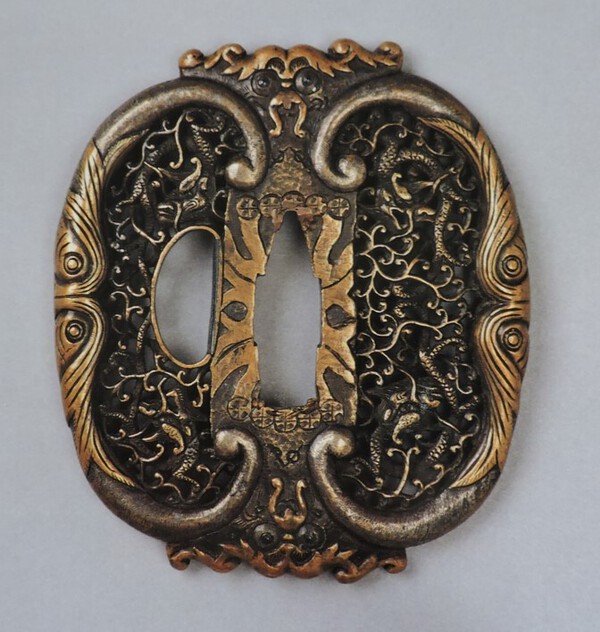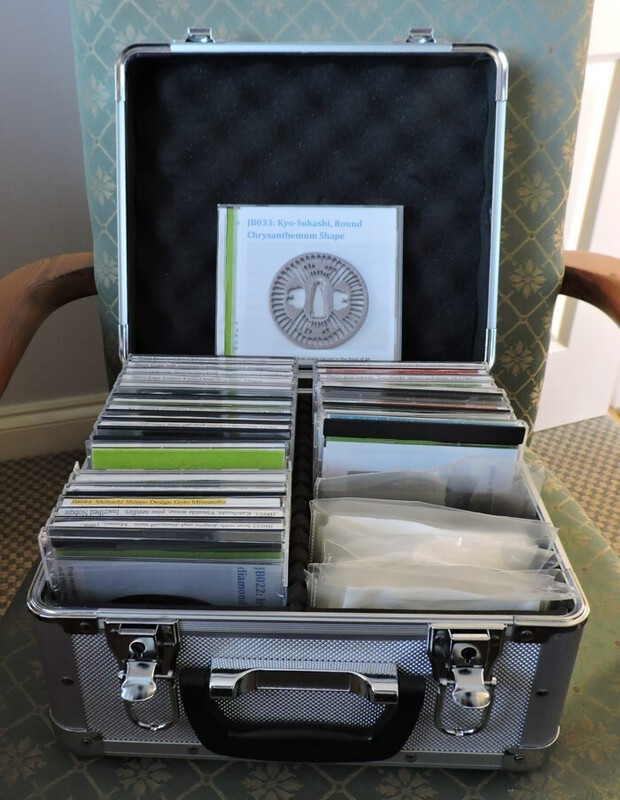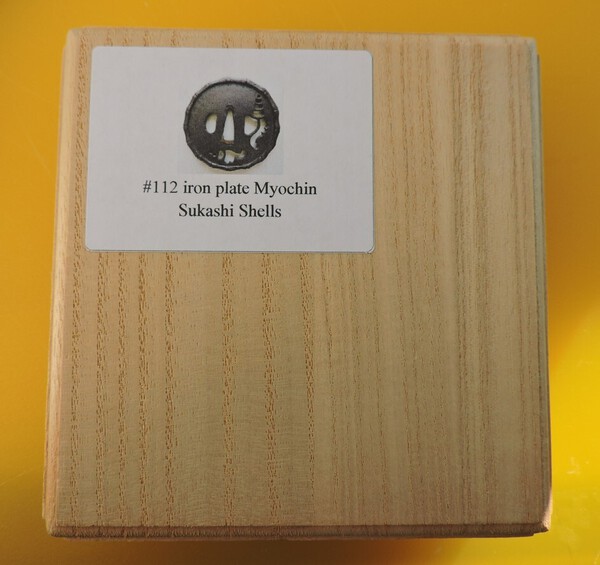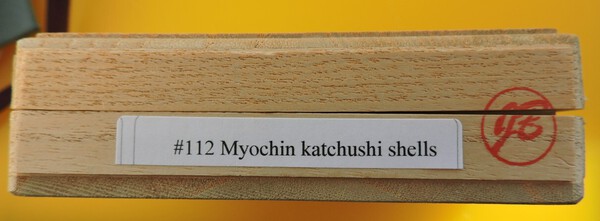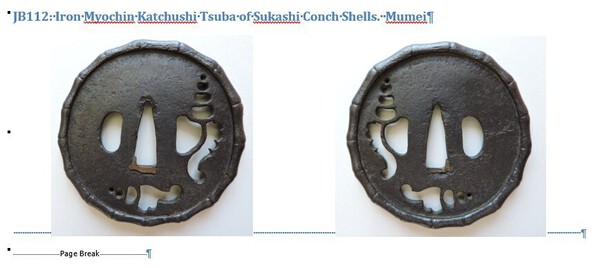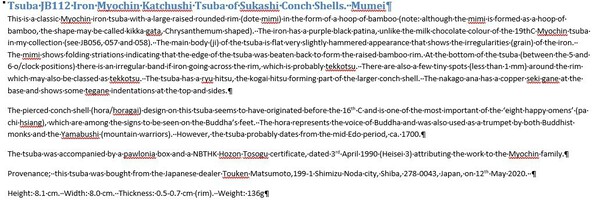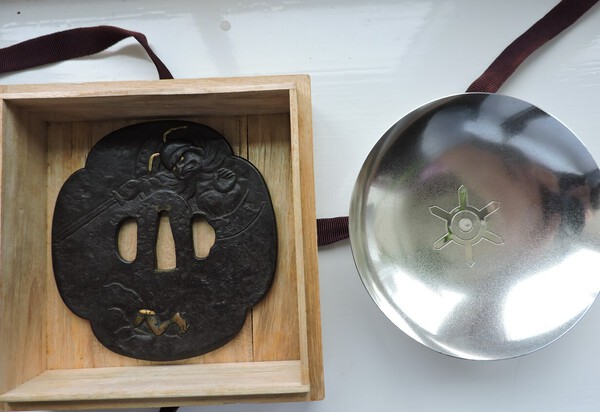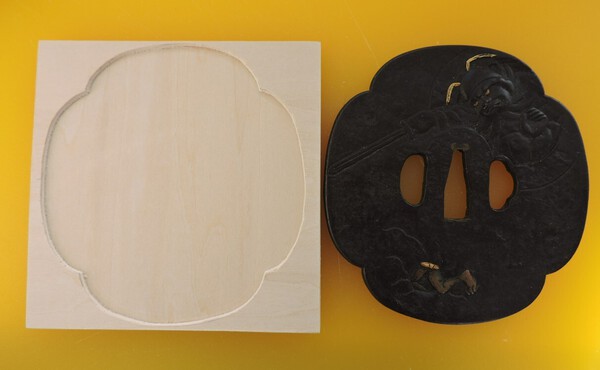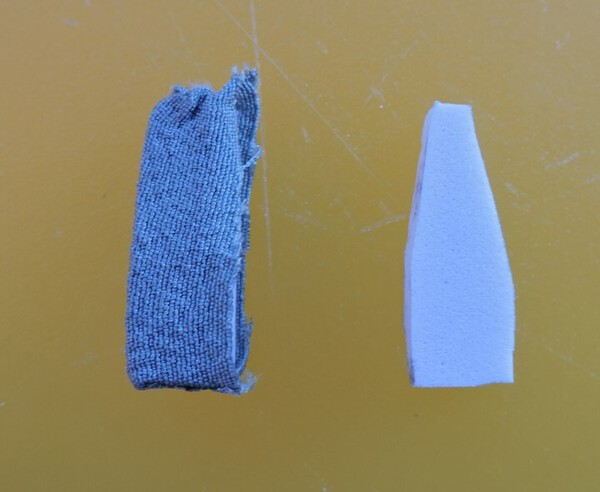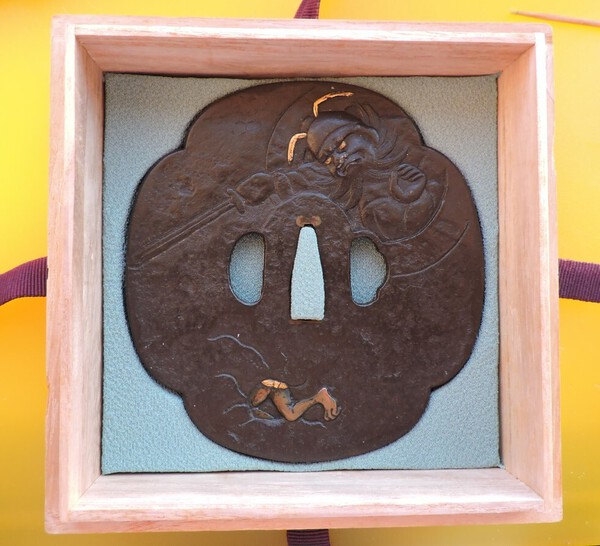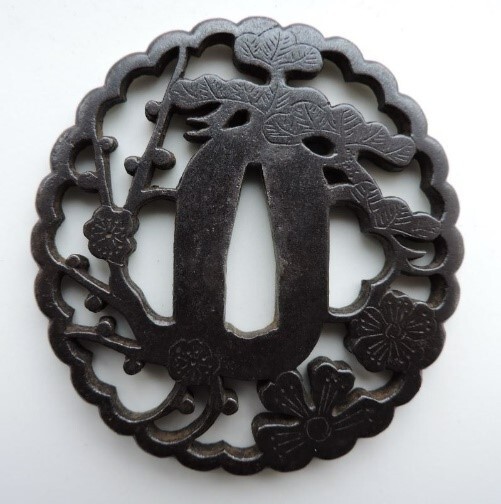
JohnTo
Members-
Posts
268 -
Joined
-
Last visited
Profile Information
-
Gender
Male
-
Location:
Dorset, England
-
Interests
Mainly tsuba but some swords and other koshirai
Profile Fields
-
Name
John B
Recent Profile Visitors
The recent visitors block is disabled and is not being shown to other users.
JohnTo's Achievements
-
I forgot all about this tsuba I bought as part of a job lot from the Albert Newall (artist and antique dealer) collection a few years ago. I think that I have posted it before, but.. At first glance the tsuba appears to be from a European rapier, but the nakago ana shows its Japanese origin. The Japanese had a craze for Portuguese and Spanish armour in the late 16th C (Momoyama) and perhaps this tsuba dates from then. The iron on the inside has become delaminated, which again makes me believe that this tsuba was made from Japanese folded iron. The inside is coated with red lacquer and I think it would be interesting to have this carbon-14 dated. The tsuba is a thin steel wan-gata (tea bowl) shape and has a large inome (boar’s eye) cut into the top. Usually, Japanese tsuba have four inome and the large single one on this tsuba makes me believe it is a European heart shape; the Heart of Jesus being a powerful symbol of the catholic faith. The tsuba is also decorated with gold and silver highlighted engravings, including three phoenixes in gold (sorry about the photo which does not make them clear). The phoenix is a bird that rises from the ashes, i.e. is resurrected, and the Christian panoply of gods is made up of the trio Father, Son and Holy Ghost. So, is this a Christian tsuba? Best regards, John
-
Hi Guys, I think that I may have a tsuba with a hidden Christian symbol. The tsuba is a variation on the common theme of horse-riding equipment. The first example (not one of mine, an internet image) shows a normal arrangement with a saddle, bit and a pair of abumi (stirrups). In my example the arrangement comprises a saddle, bit and whip. The unusual feature is that the bit has been disjointed with the part that goes in the horse’s mouth becoming separated from the rings that attach the reigns. One ring is completed missing and would lie outside the area of the tsuba and the other is separated from the central part by the seppa-dai, a separation which would be even more pronounced when mounted on a sword as the tsuka would also be present. The remaining ring of the bit, in its isolation, could be viewed as the clan mon of the Shimadzu, or a Christian cross. The tsuba is signed Hidemitsu (possibly H 01077.0, died ca.1750 and worked in Nagasaki making Hizen style sukashi tsuba). Kyushu, where Nagasaki is located, was the home of the Shimazu clan and also had a significant secret Christian population during the Edo period, as Christianity was banned. The Shimazu clan also fought against the Tokugawa at the battle of Sekigahara, so maybe their samurai did not want to openly display their clan allegiance when visiting Edo, for example. So is the isolated ring from a horse bit the Shimazu mon, a Christian symbol, or just a more abstract way of representing a common theme on a tsuba? All the best, John
-
As its Chinese New Year I thought that I would post some Chinese dragons on a couple of Chinese? Nanban mask tsuba, rather than another Japanese version of a Chinese dragon. Like cast iron tsuba (no let’s not open that again) these tsuba invoke a lot of differing opinion as to where and when they were made. The first of my tsuba is iron with four masks (lions, demons?) at the cardinal points and four dragons’ heads together with a tama jewel. The dragons appear to be both male (upside down at the bottom) and female (at the top). Each side is bordered by what are generally termed ‘Drawer Handles’. The black iron is highlighted by gold nunome, which may have been added in Japan? The second of my tsuba is brass and only has two lion/demon masks at the top and bottom. There are still the four dragon heads, two females at the top with their mouths open (talking again?) and the two male dragons beneath with whiskers (this time the right way up). The two drawer handles have been replaced with four stylised dragons, each pair holding a tama jewel in their mouths. Comparing scratch marks on this tsuba with those from a Christie’s sale catalogue (1992), it almost certain that it the one from the Soame Jenyns collection One look at the nakago ana on these tsuba tells you that these were not made for a Japanese sword or polearm. Most people seem to call these ‘Canton Tsuba’ and were made in China, starting in the Momoyama period (pre-1600) up to the late 18th C. Others claim that the Dutch East India Company imported these from as far away as Shri Lanka (old Ceylon). This claim seems to be based upon the ‘Drawer Handles’ which look like the European sword guards and some examples (see photo from RB Caldwell Masterpieces) which seem to have VOC (Vrie Oostindiche Companie) around the seppa-dai (see photo). However, the ‘Drawer handles’ seems to have been used on Ming Dynasty guards and the VOC logo looks a bit ‘iffy’ to me. IMHO, I believe these tsuba may have been taken from Korean polearms as war booty, during Hideyoshi’s campaigns (1592-1598). The Joseon Koreans and Ming Chinese were allies and were armed with the same weaponry. It seems unlikely to me that these tsuba would have been commercially exported from China to Japan with the knowledge that the nakago ana was the wrong shape and had to be modified. Later Nanban tsuba may have had fancy seppa-dai, but the nakago ana was a ‘Japanese shape’. I don’t have any corroborative evidence for this theory. All the best, John
-
I see that Alex and Dale have posted pieces with brass inlay of abstract dragons, so let me add mine. This tsuba is highly polished iron with a brown patina resembling shibuichi, which is what the auction house catalogued it as. The shape is a rounded mokko gata (nade mokko or Otafuku gata) with the ji tapering towards the edges (goishi gata). The tsuba has flush inlay (honzogan) of stylised dragons in brass, two on the front and one on the back and is signed Kashu (no) ju Katsukuni. Flush brass inlay was a speciality of the Kaga tsuba makers and Haynes says there was eight generations of the Katsukuni family in Kaga working from ca. 1700 to 1880. Anyone any ideas on the origin of the abstract dragon design? Best regards, John
-
February 10th is the start of the Chinese Year of the Dragon. I’m sure many of you have fittings with dragons, so let me get the ball rolling with start with two tsuba of mine. Perhaps, as it is the Chinese New Year, I should post some Nanban Chinese dragons, but I thought I would post these two as they seem to have nice smiley faces and do not look particularly fearsome; a good New Year omen. I have attributed both of these tsuba to the 19thC Mito School based upon the observations that the artists tended to make large iron plate tsuba with a hammered surface and raised areas of iron which they carved in detail and left their work unsigned. The surface of both tsuba is a glassy chocolate brown, which why I think they are 19thC rather than earlier. Other schools which I think could be candidates for the makers are the Myochin and the Natsuo workshops. The first tsuba is a large (9.6 x 8.7 cm) rectangular plate tsuba showing a dragon among clouds and wrapped around a diamond shape (clan mon?) in the centre. Most of the design is formed by hammering the iron around the proposed design element to form an indentation and then carving the centre. However, the iron forming the dragons head has been raised above the plate before carving. The tsuba is highlighted in parts by a light application of gold, called kakihage (shadow), giving a more subtle effect than nunome inlay. The second dragon tsuba is also a large (8.4 x 7.8 cm) iron plate, which has been roughly hammered into shape and shows many lumps and bumps, which I hope that I am correctly identifying as tekkotsu, rather than being fooled by irregularities made to look like tekkotsu (clever these artisans!). The areas containing the clouds and dragon look like they have been indented into the plate using a pre-shaped stamp, but I think that it is actually skilful forging. The dragon has a welcoming, rather than fearsome, look and the eyes are gilt to impart some life into the critter. Although the dragon is a typical three clawed Japanese variety it also has three tails, namely a long curly one, another about half the length ending with what looks like a brush used for calligraphy and a short tail, again looking like a calligraphy brush. No idea why. Comments and further information welcome Best regards for the (Chinese) New Year, Regards, John (just a guy making observations, asking questions, trying to learn)
-
George wrote '(At the moment I could do with only two good ones, but I have a few extra rougher tsuba that at least deserve *something* to be stored in properly - oh, and I'm UK based if that's relevant)' Several years ago I posted my cheap way of storing tsuba in CD jewel cases. I took a lot of stick from purists. I still have quite a few stored in this way as I don't want to invest about £20 in a kiri box for a 'B' quality tsuba. The CD jewel cases can also be stored in a custom aluminium box for storage and transportation without coming loose. They also take up a lot less space, the aluminium storage box hold about 40. Best regards, John
-
As Piers noted it can be difficult finding a specific tsuba amongst a pile of boxes if they are not labelled in some way. I put a label on top of the box with its inventory number and picture. On the one side (bottom) of the box I put a label with the inventory number together with my hanko stamp (available from Japan via Ebay). The stamp is a useful means to identify which way up the lid goes on the box and by placing the stamp in slightly different positions it ensures that the correct top goes on the box. Added to that each box contains a strip of paper (about 30 x 10 cm, long edge folded in three to fit in the box). One side shows photos, the other my description and notes (these are referenced to my main inventory). Always useful when you want to refresh your memory and sometimes think 'I got that wrong. I'll I have to update.' Photos of a typical tsuba set are attached. Best regards, John
-
Hi Les, A timely query as I am just making a liner for a tsuba box. I like to throw out the standard Japanese liners, mainly because the pegs are held in with steel tacks and can damage tsuba if the peg breaks loose. I suppose I now have more than 30 in my refurbished boxes and may have posted notes before on how I make them. The current project is a bit unusual. By coincidence I bought a silver sake cup as part of a job lot at auction recently and it came with a tsuba style box, but large 11 cm square. I then bought a monster of a tsuba, 9.6 cm, without a box. The project is not finished yet, but here are some photos. Normally I make the liner out of EVA sheeting, but this time I decided to make one out of balsa wood. I prefer using the EVA. Custom pegs are easy to make with EVA. I still have to trim this one in the photo, but it gives the idea and is shown together with an EVA blank peg Covered one is on its side and awaits final trim. EVA blank is top view. Fina pic is tsuba in its new box plus covered liner and peg, not glued and trimmed yet. Hope this helps, Best regards, John
-
Hi Dan, Helpful post for new collectors. One point to comment on is the part about tagane . 'First, I look at the area around the nakago-ana to see if there are tagane-ato (punch marks around the nakago-ana). Those punch marks are made to fit the tsuba more securely to the tang of the sword blade. Those tagane-ato punch marks should appear “crisp” and could actually be punched fairly “deep” into the tsuba (on a cast piece they appear “rounded” and are fairly shallow).' Tagane-ato are also used instead of signatures. Some Higo tsuba have very shallow rectangular tagane (four at the top and seven at the bottom). NBTHK Hozon papers that I have seen with identical marks to mine attribute the tsuba to late Higo, rather than to a specific workshop or maker (see the three tree theme example attached). Nagoyamono tsuba are made of nigurome but often sold by auction houses and Japanese dealers as shakudo and have a characteristic pattern of three punch marks at the top and seven at the bottom. There are about 20 different themes apart from the one attached (treasure ship). I did post a warning about these sometime ago attributing them to 'Mr Suzuki's workshop', the name I gave to the unknown guy. These are often sold at inflated prices, IMHO, so buyer beware. Hope this is helpful, John
-
Sorry for the delay in acknowledging your replies, been away from the computer and tsuba for a while. Thanks for the examples and reference to the Kumamoto museum (very interesting exhibits) Please note that for some unknown reason my photos have been scrambled from the order in which I loaded them so they appear as 1. Example 2 2. Example 1 3. NBTHK Hozon for Example 1 4. My tsuba: Omote 5. Harunobu print of Potted Trees 6. My tsuba: Ura with tagane 7. NBTHK Hozon for Example 2 8. Christian Malterre picture 9. Christian Malterre text 10. ‘Akasaka’ Example Best regards, John
-
I bought the first tsuba in the pics below a couple of years ago (JB125) and was described as a Higo tsuba, an attribution that I was happy with at the time (and still am) given my limited knowledge. The tsuba is a kikka gata (chrysanthemum shaped) iron sukashi tsuba with a flat migaki-ji (polished) surface with light engraving (kebori: hair carvings) to highlight the blossom and pine tree design. The iron has a black patina with a fine crystalline structure with few apparent inhomogeneous iron inclusions (tekottsu). The design consists of a mixture of cherry (split petals) and plum (rounded petals) blossom with the branch of a pine tree. The sukashi is cut vertically through the plate with no rounding to the edges. The mimi (rim) is defined by the 28-petal chrysanthemum design and there is a slight rounding to the edges. The tsuba has ryu-hitsu, the kogai hitsu being of regular shape and the kodzuka hitsu is bordered by a blossom branch. The nakago ana has no sekigane and shows some widening at the sides and filing at the bottom to fit a blade. The interesting feature is the groups of small, shallow rectangular tagane at the top (four) and bottom (seven) of the nakago ana, which were almost certainly maker’s marks in place of a signature, as the tsuba is mumei. I’ll get back to these later. Statistics: Height: 7.9 cm, Width: 7.4 cm, Thickness (rim): 0.45 cm, Weight: 116 g The design seems to be depict one (or both) of the following stories. The first is the Noh play, Hachi no Ki (the potted trees), in which Lord Tokiyori, disguised as a priest, begs shelter from a former retainer, Tsuneyo Genzayemon, who has fallen on hard times. Tsuneyo and his wife are only able to offer the priest boiled millet for food and, as it is cold and snowing, they chop up their three precious bonsai (plum, cherry and pine) and burn them to keep their guest warm. Six months later Hojo no Tokiyori (ruled at Kamakura 1246-1256) summoned Tsuneyo and granted him three fiefs (Plumfield in Kaga, Cherrywell in Etchu and Pine-branch in Kozuke). The 28-petal chrysanthemum probably alludes to Hojo no Tokiyori. A yukioe print of a scene from the play is by Harunobu is attached. The second theme that this tsuba may relate to is the bunraku and kabuki play ‘Sugawara and the Secrets of Calligraphy’. The main characters of the play are Umemaru (plum tree), Sakuramaru (Cherry Tree), and Matsuomaru (Pine tree). In order to save the son of Sugawara, Matsuomaru used his own son as a decoy who was killed. Anyway, back to the tagane. I started to keep an eye open for tsuba with similar tagane marks and some reliable authentication (e.g. NBTHK). Below are just a couple that I found together with part of an article published by Christian Malterre (sorry Christian, can’t remember where I got this from so that I can acknowledge your work) that attribute these ‘kakushi tagane’ to the two Higo masters: Kamiyoshi Fukanobu and Kamiyoshi Rajuku. There is also an additional tsuba showing these tagane that was for sale on Ebay, but attributed the tsuba to Akasaka. The two tsuba with NBTHK Hozon papers are attributed to ‘mumei kodai Higo (unsigned late Higo)’, which represents quite a wide range of possible makers. Higo (now Kumamoto prefecture in Kyushu, southern Japan) was the home to four major (and numerous lesser) tsuba schools, namely: Hayashi, Hirata, Nishigaki and Shimizu (the founder Jinbei Shimizu renamed the school Jingo, famous for brass inlay). Higo tsuba were highly regarded in the Edo period as illustrated by the old saying ‘For the best katana go to Bizen, for the best tsuba look to Higo’. (Information from Yatsuhiro Municipal Museum website). The pattern of light tagane punch marks is obviously a ‘signature’ rather than an adjustment to the size of the nakago. The NBTHK does not seem to be averse to attributing mumei tsuba to a particular tsubako, but the best that they do with these characteristic marks is ‘Late Higo’, which encompasses a lot of workshops as well as artisans. I have found other examples, but either the photos do not allow close examination of the tagane or the nakago has been modified. My questions are these: Can these particular kakushi tagane marks be attributed to a particular artist/school, or were they used by several (unknown) artists in different workshops over different periods of time? Also were these tsuba faked a lot? Pictures: 1. My tsuba: Omote 2. My tsuba: Ura with tagane 3. Harunobu print of Potted Trees 4. Example 1 5. NBTHK Hozon for Example 1 6. Example 2 7. NBTHK Hozon for Example 2 8. Christian Malterre picture 9. Christian Malterre text 10. ‘Akasaka’ Example Best Regards, John (just a guy making observations, asking questions, trying to learn)
-
There are plenty of scientific techniques which could clarify the cast iron issue: carbon-14 dating to show when the iron was smelted, isotopic and trace metal analysis to show where the iron ore came from and crystalline analysis to show the forging history. However no one is going to do these because these tsuba are junk and there are far more interesting research topics for scientists to put their name to and get funding for! I opened up a discussion topic some time ago about 'Mr Suzuki's workshop'. He was a name I attached to the owner of a workshop in Nagoya who made cast nigurome tsuba that look rather like shakudo, probably in the 18thC. He made about 20 different designs all of which had the same common features: size, single ryo hitsu,nanako ji and gilded sort of nanako mimi plus a pattern of tagane in place of a signature (three at top plus 2, 3 and 2 at the bottom) See attached pic of the treasure ship tsuba to refresh memories. These tsuba are still being sold by Japanese dealers as shakudo, Mino, etc when they are not and experienced dealers should know better than to pass these off as quality pieces. The point I am trying to make is that Japanese craftsmen have been 'forging' cheap quality tsuba in the Edo period, but nobody wants to become an expert in poor quality antiques? Best regards, John
-
Just taken delivery of a NBTHK Hozon Akasaka sukashi crane tsuba. While waiting for the tsuba to arrive Jimi-san sent several emails praising the tsuba. I thought that he might be just hyping it up a bit. He wasn't. Superb tsuba and I'm extremely pleased. Its text book Akasaka, which is what I was looking for and the iron is great showing the multiple layers of the Akasaka school, plus the tsurumaru design is particularly lovely. Had a little problem trying to pay by credit card, but PayPal worked OK. He has several other tsuba that I like the look of, but my collection debt is already rather large and despite holding my breath until I turn purple and stamping my feet etc, my (lovely) wife says no more money for the time being. Thanks Jimi
-
In a couple of Japanese samurai films, 'When the last sword is drawn' and 'Sekigahara' there are scenes where one of the characters is cleaning out his ears with a kogai. Regards, John



